

Compact Muon Solenoid
LHC, CERN
| CMS-BPH-21-003 ; CERN-EP-2023-109 | ||
| Observation of new structure in the J/$\psi$J/$\psi$ mass spectrum in proton-proton collisions at $ \sqrt{s} = $ 13 TeV | ||
| CMS Collaboration | ||
| 12 June 2023 | ||
| Phys. Rev. Lett. 132 (2024) 111901 | ||
| Abstract: A search is reported for near-threshold structures in the J/$\psi$J/$\psi$ invariant mass spectrum produced in proton-proton collisions at $ \sqrt{s} = $ 13 TeV from data collected by the CMS experiment, corresponding to an integrated luminosity of 135 fb$^{-1}$. A new structure is observed with a significance above 5 standard deviations at a mass of 6552 $ \pm $ 10 (stat) $ \pm $ 12 (syst) MeV. Another structure with even higher significance is found at a mass of 6927 $ \pm $ 9 (stat) $ \pm $ 4 (syst) MeV, which is consistent with the X(6900) resonance reported by the LHCb experiment and confirmed by the ATLAS experiment. Evidence for another new structure, with a local significance of 4.1 standard deviations, is found at a mass of 7287 $ ^{+20}_{-18} $ (stat) $\pm$ 5 (syst) MeV. The masses and significances are obtained in a model without considering possible quantum mechanical interference between the resonances. Incorporating this interference provides a better description of the mass spectrum between the resonances and shifts the measured masses by up to 150 MeV. | ||
| Links: e-print arXiv:2306.07164 [hep-ex] (PDF) ; CDS record ; inSPIRE record ; HepData record ; Physics Briefing ; CADI line (restricted) ; | ||
| Figures | |

png pdf |
Figure 1:
The J/$\psi$J/$\psi$ invariant mass spectrum in the range up to 9 GeV, with fits consisting of three signal functions ($ \mathrm{BW_1} $, $ \mathrm{BW_2} $ and $ \mathrm{BW_3} $) and a background model (see text). The left plot shows the fit without interference. The right plot shows the fit that includes interference, where ``Interfering BWs'' refers to the total contribution of all the interfering amplitudes, and their cross-terms. For clarity, only the sum of the three background components (NRSPS+DPS+$ \mathrm{BW_0} $) is shown on the plots. The lower portion of the plots shows the pulls, i.e., the number of standard deviations (statistical uncertainties only) that the binned data differ from the fit. |

png pdf |
Figure 1-a:
The J/$\psi$J/$\psi$ invariant mass spectrum in the range up to 9 GeV, with fits consisting of three signal functions ($ \mathrm{BW_1} $, $ \mathrm{BW_2} $ and $ \mathrm{BW_3} $) and a background model (see text). The plot shows the fit without interference. For clarity, only the sum of the three background components (NRSPS+DPS+$ \mathrm{BW_0} $) is shown. The lower portion of the plot shows the pulls, i.e., the number of standard deviations (statistical uncertainties only) that the binned data differ from the fit. |
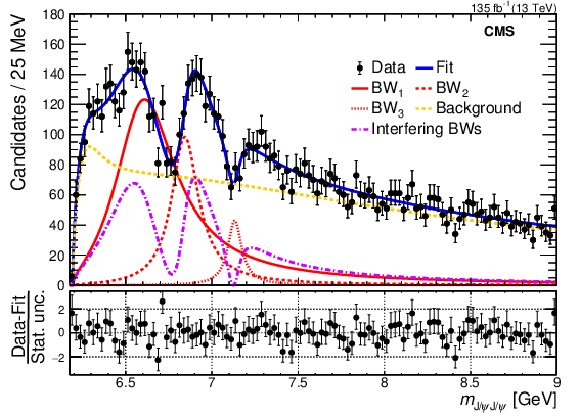
png pdf |
Figure 1-b:
The J/$\psi$J/$\psi$ invariant mass spectrum in the range up to 9 GeV, with fits consisting of three signal functions ($ \mathrm{BW_1} $, $ \mathrm{BW_2} $ and $ \mathrm{BW_3} $) and a background model (see text). The right shows the fit that includes interference, where ``Interfering BWs'' refers to the total contribution of all the interfering amplitudes, and their cross-terms. For clarity, only the sum of the three background components (NRSPS+DPS+$ \mathrm{BW_0} $) is shown. The lower portion of the plot shows the pulls, i.e., the number of standard deviations (statistical uncertainties only) that the binned data differ from the fit. |
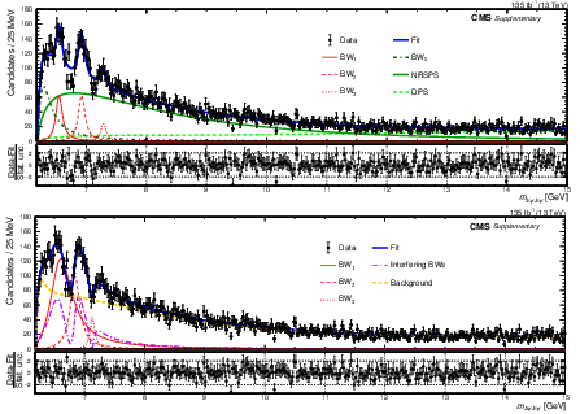
png pdf |
Figure A1:
The J/$\psi$J/$\psi$ invariant mass spectrum with the no-interference fit (upper) and the interference fit (lower) in the full fit range (see text for model details). The ``Interference BWs'' curve is the total contribution of all the interference amplitudes and their cross terms. The lower portion of the plots shows the pulls, i.e.,, the number of standard deviations (statistical uncertainties only) that the binned data differ from the fit. |
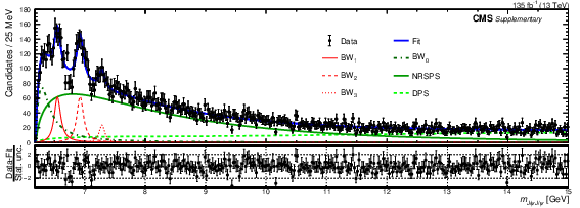
png pdf |
Figure A1-a:
The J/$\psi$J/$\psi$ invariant mass spectrum with the no-interference interference fit in the full fit range (see text for model details). The lower portion of the plots shows the pulls, i.e.,, the number of standard deviations (statistical uncertainties only) that the binned data differ from the fit. |
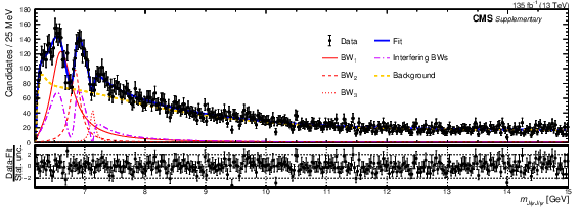
png pdf |
Figure A1-b:
The J/$\psi$J/$\psi$ invariant mass spectrum with the no-interference interference fit in the full fit range (see text for model details). The ``Interference BWs'' curve is the total contribution of all the interference amplitudes and their cross terms. The lower portion of the plots shows the pulls, i.e.,, the number of standard deviations (statistical uncertainties only) that the binned data differ from the fit. |

png pdf |
Figure B1:
The J/$\psi$J/$\psi$ invariant mass spectrum with fits using LHCb models [14]: Model I (no-interference) (upper) and Model II (interference) (lower). Model details are given in the text. The ``Interfering components'' is the total contribution of $ \mathrm{BW_{1}} $, NRSPS, and their interference. The lower portion of the plots shows the pulls between the binned data and the fit. |
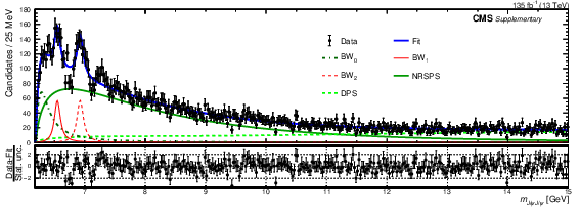
png pdf |
Figure B1-a:
The J/$\psi$J/$\psi$ invariant mass spectrum with fits using LHCb models [14] for Model I (no-interference). Model details are given in the text. The lower portion of the plot shows the pulls between the binned data and the fit. |

png pdf |
Figure B1-b:
The J/$\psi$J/$\psi$ invariant mass spectrum with fits using LHCb models [14] Model II (interference). Model details are given in the text. The ``Interfering components'' is the total contribution of $ \mathrm{BW_{1}} $, NRSPS, and their interference. The lower portion of the plot shows the pulls between the binned data and the fit. |
| Tables | |

png pdf |
Table 1:
Summary of the fit results for the J/$\psi$J/$\psi$ invariant mass distribution. The mass $ m $ and natural width $ \Gamma $ for both the no-interference model and the interference model, and the signal yields $ N $ for the no-interference model, are given for the three signal structures. The dual uncertainties are the statistical followed by the systematic components, and single uncertainties are only statistical. |

png pdf |
Table 2:
Dominant contributions to the systematic uncertainties in masses and widths, in MeV, for the two fits. The ``Total uncertainty'' is the quadratic sum of all individual components, including the unlisted non-dominant contributions. |

png pdf |
Table B1:
Summary of results for the two LHCb fit models from LHCb and CMS: the mass $ m $ and natural width $ \Gamma $, in MeV, are given for the principal structures (the Breit--Wigner function at the threshold is not included in Model I), and LHCb values not reported in Ref. [14] are marked as ``$ \text{---} $''. Single uncertainties are statistical only. |
| Summary |
| In summary, the J/$\psi$J/$\psi$ invariant mass spectrum has been presented. The data were collected with the CMS detector from pp collisions at $ \sqrt{s} = $ 13 TeV and correspond to an integrated luminosity of 135 fb$ ^{-1} $. Two new structures, tentatively named X(6600) and X(7300), are found with masses of 6552 $ \pm $ 10 (stat) $ \pm $ 12 (syst) MeV and 7287 $ ^{+20}_{-18} $ (stat) $ \pm $ 5 (syst) MeV, and the X(6900) structure observed by LHCb is confirmed with a mass of 6927 $ \pm $ 9 (stat) $ \pm $ 4 (syst) MeV. The local significances of these peaks are, for increasing mass, 6.5, 9.4, and 4.1 standard deviations. These results are from a fit that does not include interference effects. Adding interference terms between the three signals results in better agreement to the data in the regions between the resonances and results in shifts of the resonance parameters. Numeric results are provided in the HEPData record [61]. As this Letter was being finalized the ATLAS Collaboration released a paper [62] confirming the X(6900) structure in the J/$\psi$J/$\psi$ spectrum, and also reported near-threshold excesses, including a possible feature in the $\psi$(2S) J/$\psi$ channel. |
| References | ||||
| 1 | M. Gell-Mann | A schematic model of baryons and mesons | PL 8 (1964) 214 | |
| 2 | Belle Collaboration | Observation of a narrow charmoniumlike state in exclusive $ {\mathrm{B}^{\pm}} \to \mathrm{K^{\pm}} \pi^{+} \pi^{-} \mathrm{J}/\psi $ decays | PRL 91 (2003) 262001 | hep-ex/0309032 |
| 3 | A. Ali, L. Maiani, and A. D. Polosa | Multiquark hadrons | Cambridge University Press, Cambridge, 2019 link |
|
| 4 | N. Brambilla et al. | The XYZ states: experimental and theoretical status and perspectives | Phys. Rept. 873 (2020) 1 | 1907.07583 |
| 5 | M. Nielsen et al. | Supersymmetry in the double-heavy hadronic spectrum | PRD 98 (2018) 034002 | 1805.11567 |
| 6 | M. Nielsen and S. J. Brodsky | Hadronic superpartners from a superconformal and supersymmetric algebra | PRD 97 (2018) 114001 | 1802.09652 |
| 7 | J. J. Aubert et al. | Experimental observation of a heavy particle $\mathrm{J}$ | PRL 33 (1974) 1404 | |
| 8 | J. E. Augustin et al. | Discovery of a narrow resonance in $ \mathrm{e}^+\mathrm{e}^- $ annihilation | PRL 33 (1974) 1406 | |
| 9 | K. Yi | Experimental review of structures in the $ \mathrm{J}/\psi\phi $ mass spectrum | Int. J. Mod. Phys. A 28 (2013) 1330020 | 1308.0772 |
| 10 | BaBar Collaboration | Evidence for the decay $ \mathrm{X}{3872} \to \mathrm{J}/\psi\omega $ | PRD 82 (2010) 011101 | 1005.5190 |
| 11 | LHCb Collaboration | Observation of new resonances decaying to $ \mathrm{J}/\psi \mathrm{K^+} $ and $ \mathrm{J}/\psi \phi $ | PRL 127 (2021) 082001 | 2103.01803 |
| 12 | LHCb Collaboration | Search for beautiful tetraquarks in the $ \Upsilon{\textrm{(1S)}}\mu^{+}\mu^{-} $ invariant-mass spectrum | JHEP 10 (2018) 086 | 1806.09707 |
| 13 | CMS Collaboration | Measurement of the $ \Upsilon{\textrm{(1S)}} $ pair production cross section and search for resonances decaying to $ \Upsilon{\textrm{(1S)}}\mu^{+}\mu^{-} $ in proton-proton collisions at $ \sqrt{s} = $ 13 TeV | PLB 808 (2020) 135578 | CMS-BPH-18-002 2002.06393 |
| 14 | LHCb Collaboration | Observation of structure in the $ \mathrm{J}/\psi $-pair mass spectrum | Sci. Bull. 65 (2020) 1983 | 2006.16957 |
| 15 | J.-Z. Wang, D.-Y. Chen, X. Liu, and T. Matsuki | Producing fully charm structures in the $ \mathrm{J}/\psi $-pair invariant mass spectrum | PRD 103 (2021) 071503 | 2008.07430 |
| 16 | H.-X. Chen, W. Chen, X. Liu, and S.-L. Zhu | Strong decays of fully-charm tetraquarks into di-charmonia | Sci. Bull. 65 (2020) 1994 | 2006.16027 |
| 17 | M. A. Bedolla, J. Ferretti, C. D. Roberts, and E. Santopinto | Spectrum of fully-heavy tetraquarks from a diquark+antidiquark perspective | EPJC 80 (2020) 1004 | 1911.00960 |
| 18 | X. Jin, Y. Xue, H. Huang, and J. Ping | Full-heavy tetraquarks in constituent quark models | EPJC 80 (2020) 1083 | 2006.13745 |
| 19 | M.-S. Liu, F.-X. Liu, X.-H. Zhong, and Q. Zhao | Full-heavy tetraquark states and their evidences in the LHCb di-$ \mathrm{J}/\psi $ spectrum | 2006.11952 | |
| 20 | F.-X. Liu, M.-S. Liu, X.-H. Zhong, and Q. Zhao | Higher mass spectra of the fully-charmed and fully-bottom tetraquarks | PRD 104 (2021) 116029 | 2110.09052 |
| 21 | R. Zhu | Fully-heavy tetraquark spectra and production at hadron colliders | NPB 966 (2021) 115393 | 2010.09082 |
| 22 | J. F. Giron and R. F. Lebed | Simple spectrum of $ c\bar c c\bar c $ states in the dynamical diquark model | PRD 102 (2020) 074003 | 2008.01631 |
| 23 | Y. Iwasaki | Is a state $ \mathrm{c}\overline{\mathrm{c}}\mathrm{c}\overline{\mathrm{c}} $ found at 6.0GeV? | PRL 36 (1976) 1266 | |
| 24 | K.-T. Chao | The ($ \mathrm{c}\mathrm{c} $)-($ \overline{\mathrm{c}}\overline{\mathrm{c}} $) (diquark-antidiquark) states in $ \mathrm{e}^+ \mathrm{e}^- $ annihilation | Z. Phys. C 7 (1981) 317 | |
| 25 | A. V. Berezhnoy, A. V. Luchinsky, and A. A. Novoselov | Heavy tetraquarks production at the LHC | PRD 86 (2012) 034004 | 1111.1867 |
| 26 | J. Wu et al. | Heavy-flavored tetraquark states with the $ \mathrm{Q} \mathrm{Q} \overline{\mathrm{Q}} \overline{\mathrm{Q}} $ configuration | PRD 97 (2018) 094015 | 1605.01134 |
| 27 | Y. Bai, S. Lu, and J. Osborne | Beauty-full tetraquarks | PLB 798 (2019) 134930 | 1612.00012 |
| 28 | Z.-G. Wang | Analysis of the $ \mathrm{Q} \mathrm{Q} \overline{\mathrm{Q}} \overline{\mathrm{Q}} $ tetraquark states with QCD sum rules | EPJC 77 (2017) 432 | 1701.04285 |
| 29 | M. N. Anwar et al. | Spectroscopy and decays of the fully-heavy tetraquarks | EPJC 78 (2018) 647 | 1710.02540 |
| 30 | J.-M. Richard, A. Valcarce, and J. Vijande | String dynamics and metastability of all-heavy tetraquarks | PRD 95 (2017) 054019 | 1703.00783 |
| 31 | A. Esposito and A. D. Polosa | A $ \mathrm{b}\mathrm{b} \overline{\mathrm{b}}\overline{\mathrm{b}} $ di-bottomonium at the LHC? | EPJC 78 (2018) 782 | 1807.06040 |
| 32 | M. Karliner, S. Nussinov, and J. L. Rosner | $ \mathrm{Q} \mathrm{Q} \overline{\mathrm{Q}} \overline{\mathrm{Q}} $ states: Masses, production, and decays | PRD 95 (2017) 034011 | 1611.00348 |
| 33 | M.-S. Liu, Q.-F. Lü , X.-H. Zhong, and Q. Zhao | All-heavy tetraquarks | PRD 100 (2019) 016006 | 1901.02564 |
| 34 | W. Chen et al. | Hunting for exotic doubly hidden-charm/bottom tetraquark states | PLB 773 (2017) 247 | 1605.01647 |
| 35 | G.-J. Wang, L. Meng, and S.-L. Zhu | Spectrum of the fully-heavy tetraquark state $ QQ\overline Q' \overline Q' $ | PRD 100 (2019) 096013 | 1907.05177 |
| 36 | C. Gong et al. | Nature of $ \mathrm{X}(6900) $ and its production mechanism at LHCb | PLB 824 (2022) 136794 | 2011.11374 |
| 37 | B.-D. Wan and C.-F. Qiao | Gluonic tetracharm configuration of $ \mathrm{X}(6900) $ | PLB 817 (2021) 136339 | 2012.00454 |
| 38 | J.-Z. Wang, X. Liu, and T. Matsuki | Fully-heavy structures in the invariant mass spectrum of $ \mathrm{J}/\psi \psi(3686) $, $ \mathrm{J}/\psi \psi(3770) $, $ \psi(3686)\psi(3686) $, and $ \mathrm{J}/\psi \Upsilon{\textrm{(1S)}} $ at hadron colliders | PLB 816 (2021) 136209 | 2012.03281 |
| 39 | CMS Collaboration | Precision luminosity measurement in proton-proton collisions at $ \sqrt{s} = $ 13 TeV in 2015 and 2016 at CMS | EPJC 81 (2021) 800 | CMS-LUM-17-003 2104.01927 |
| 40 | CMS Collaboration | CMS luminosity measurement for the 2017 data-taking period at $ \sqrt{s} = $ 13 TeV | CMS Physics Analysis Summary, 2018 link |
CMS-PAS-LUM-17-004 |
| 41 | CMS Collaboration | CMS luminosity measurement for the 2018 data-taking period at $ \sqrt{s} = $ 13 TeV | CMS Physics Analysis Summary, 2019 CMS-PAS-LUM-18-002 |
CMS-PAS-LUM-18-002 |
| 42 | CMS Collaboration | The CMS experiment at the CERN LHC | JINST 3 (2008) S08004 | |
| 43 | T. Sjöstrand et al. | An introduction to PYTHIA 8.2 | Comput. Phys. Commun. 191 (2015) 159 | 1410.3012 |
| 44 | Y. Gao et al. | Spin determination of single-produced resonances at hadron colliders | PRD 81 (2010) 075022 | 1001.3396 |
| 45 | A. V. Gritsan et al. | New features in the JHU generator framework: Constraining Higgs boson properties from on-shell and off-shell production | PRD 102 (2020) 056022 | 2002.09888 |
| 46 | H. Jung et al. | The CCFM Monte Carlo generator CASCADE version 2.2.03 | EPJC 70 (2010) 1237 | 1008.0152 |
| 47 | H.-S. Shao | HELAC-ONIA: An automatic matrix element generator for heavy quarkonium physics | Comput. Phys. Commun. 184 (2013) 2562 | 1212.5293 |
| 48 | J.-P. Lansberg and H.-S. Shao | $ \mathrm{J}/\psi $-pair production at large momenta: Indications for double parton scatterings and large $ \alpha_\mathrm{S}^5 $ contributions | PLB 751 (2015) 479 | 1410.8822 |
| 49 | J.-P. Lansberg and H.-S. Shao | Production of $ \mathrm{J}/\psi+\eta_{\mathrm{c}} $ versus $ \mathrm{J}/\psi+\mathrm{J}/\psi $ at the LHC: Importance of real $ \alpha_\mathrm{S}^5 $ corrections | PRL 111 (2013) 122001 | 1308.0474 |
| 50 | H.-S. Shao | HELAC-ONIA 2.0: An upgraded matrix-element and event generator for heavy quarkonium physics | Comput. Phys. Commun. 198 (2016) 238 | 1507.03435 |
| 51 | GEANT4 Collaboration | GEANT 4---a simulation toolkit | NIM A 506 (2003) 250 | |
| 52 | CMS Collaboration | The CMS trigger system | JINST 12 (2017) P01020 | CMS-TRG-12-001 1609.02366 |
| 53 | CMS Collaboration | Performance of CMS muon reconstruction in pp collision events at $ \sqrt{s}= $ 7 TeV | JINST 7 (2012) P10002 | CMS-MUO-10-004 1206.4071 |
| 54 | Particle Data Group Collaboration | Review of Particle Physics | PTEP 2022 (2022) 083C01 | |
| 55 | CMS Collaboration | Supplemental Material | at [URL will be inserted by publisher] for the fit projections in full range and the fit results with LHCb models | |
| 56 | F. Von Hippel and C. Quigg | Centrifugal-barrier effects in resonance partial decay widths, shapes, and production amplitudes | PRD 5 (1972) 624 | |
| 57 | S. U. Chung | Helicity-coupling amplitudes in tensor formalism | PRD 48 (1993) 1225 | |
| 58 | X.-K. Dong et al. | Coupled-channel interpretation of the LHCb double-$ \mathrm{J}/\psi $ spectrum and hints of a new state near the $ \mathrm{J}/\psi\mathrm{J}/\psi $ threshold | PRL 126 (2021) 132001 | 2009.07795 |
| 59 | F.-K. Guo, X.-H. Liu, and S. Sakai | Threshold cusps and triangle singularities in hadronic reactions | Prog. Part. Nucl. Phys. 112 (2020) 103757 | 1912.07030 |
| 60 | R. Tiwari, D. P. Rathaud, and A. K. Rai | Spectroscopy of all charm tetraquark states | Indian J. Phys. 97 (2023) 943 | 2108.04017 |
| 61 | CMS Collaboration | HEPData record for this analysis | link | |
| 62 | ATLAS Collaboration | Observation of an excess of di-charmonium events in the four-muon final state with the ATLAS detector | Submitted to Phys. Rev. Lett, 2023 | 2304.08962 |

|
Compact Muon Solenoid LHC, CERN |

|

|

|

|

|

|